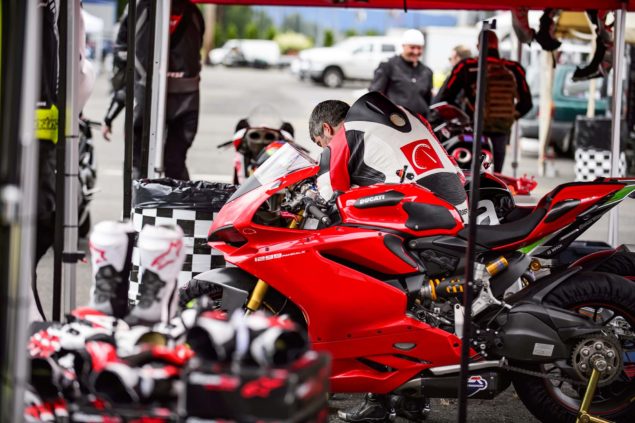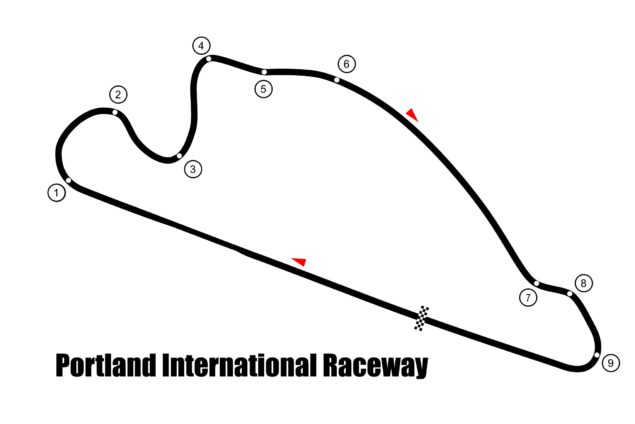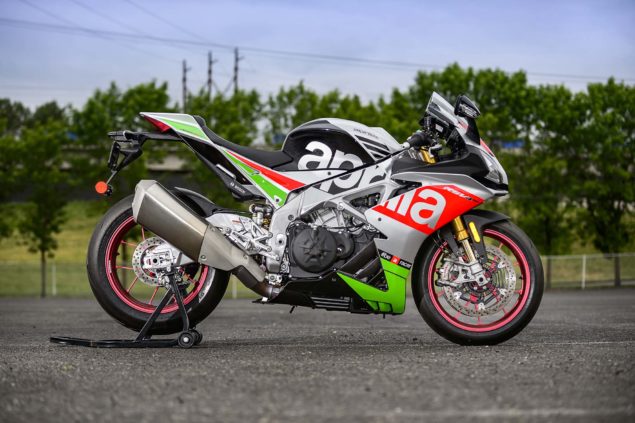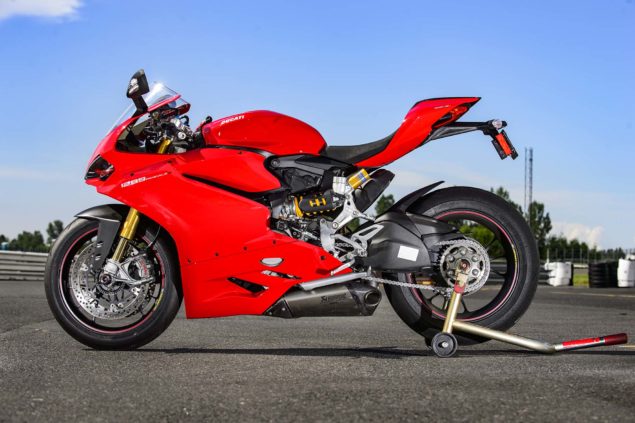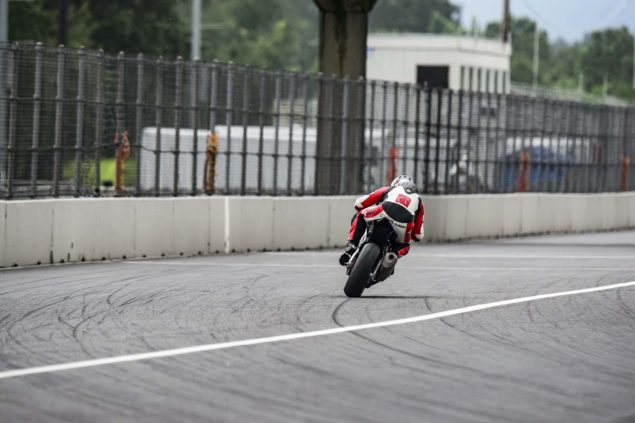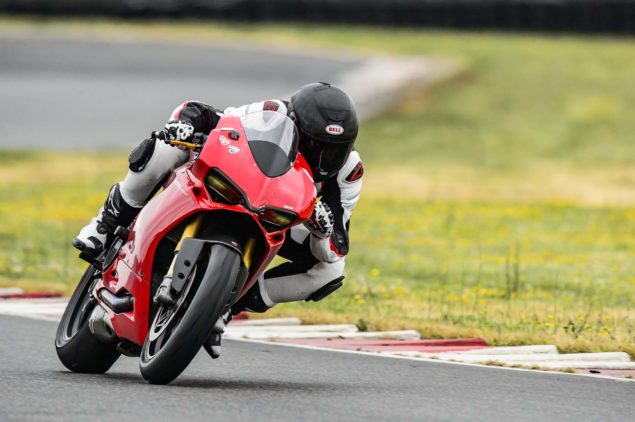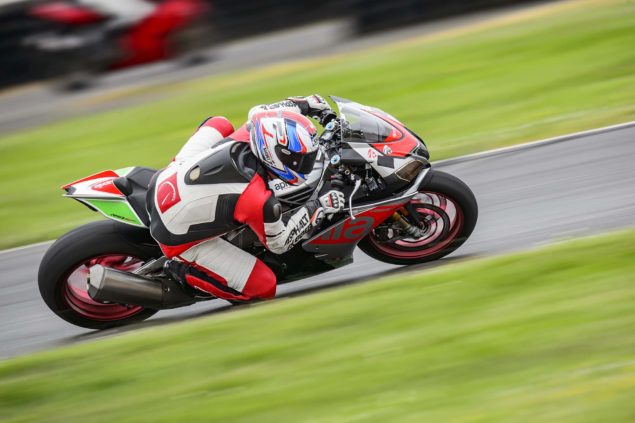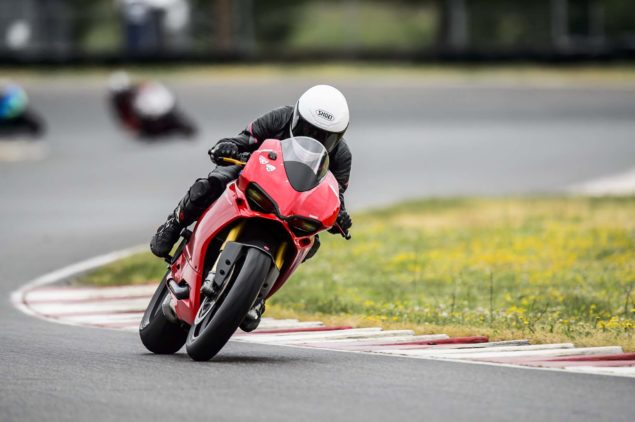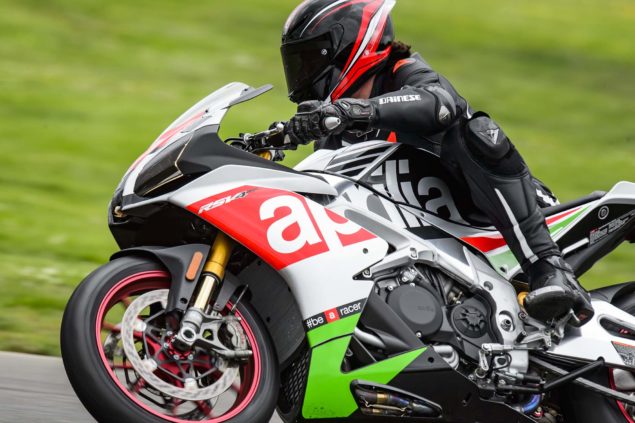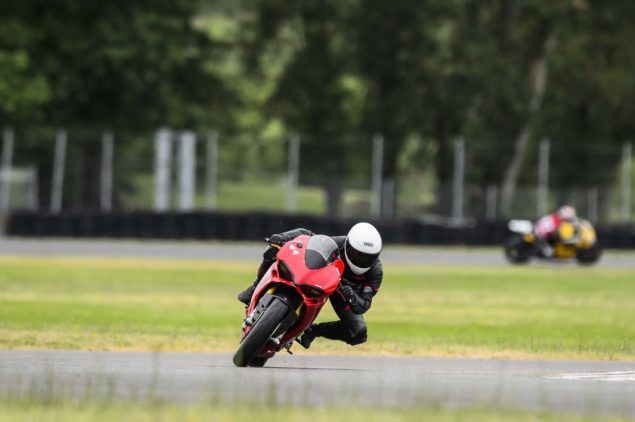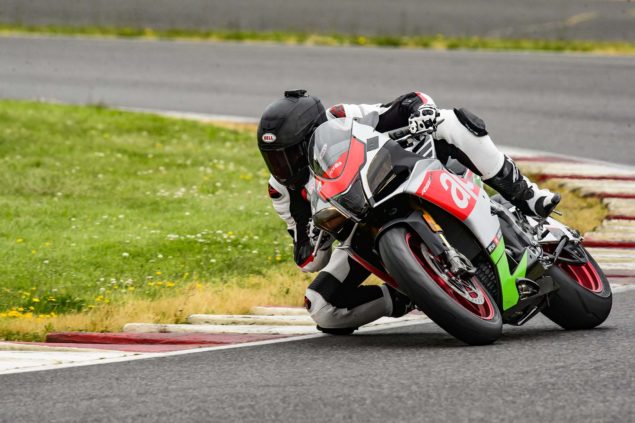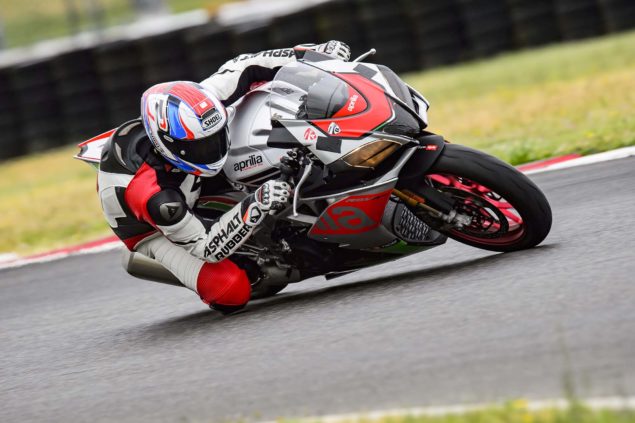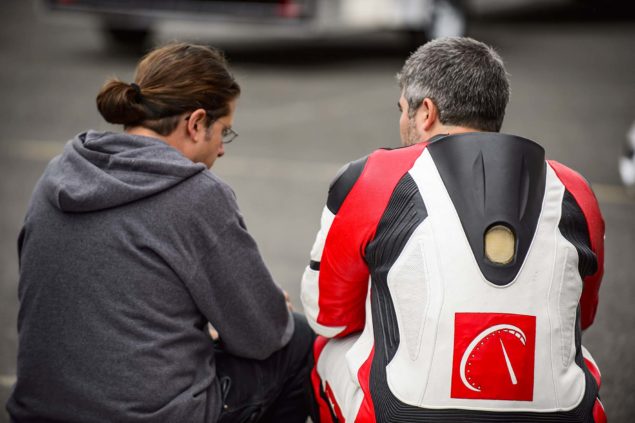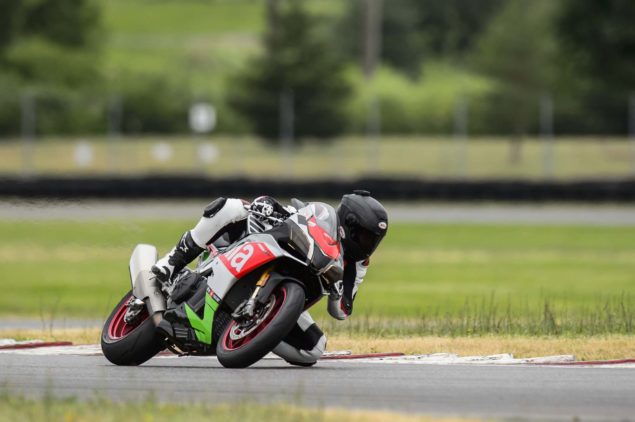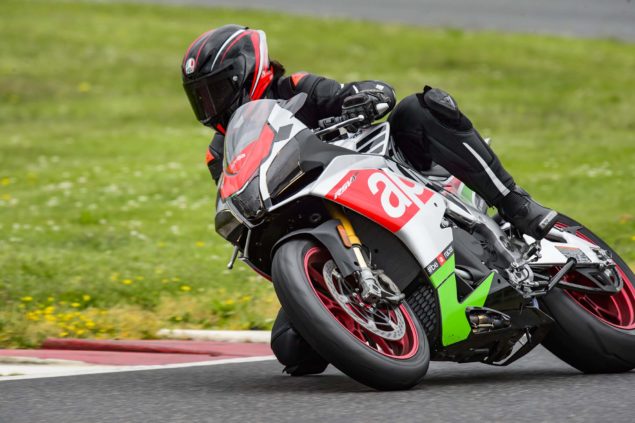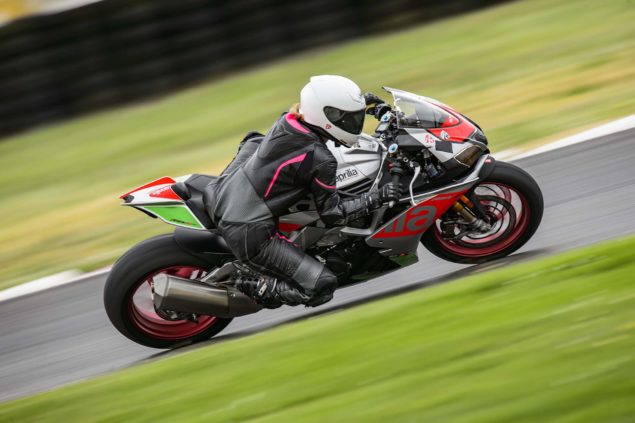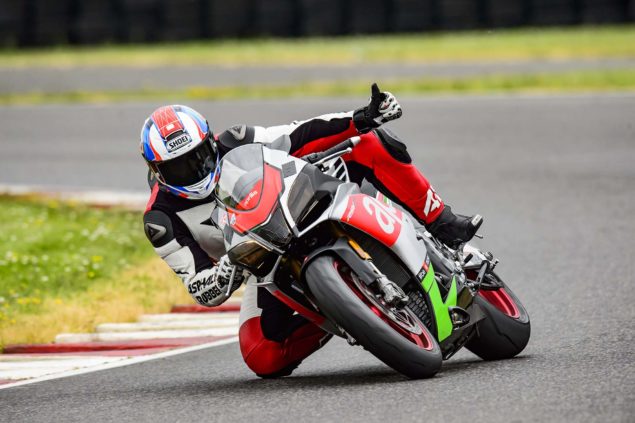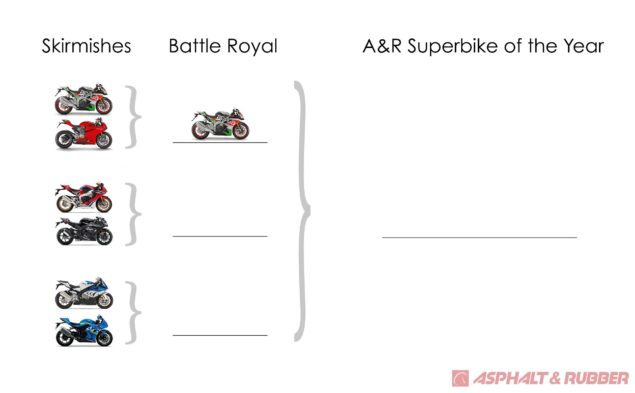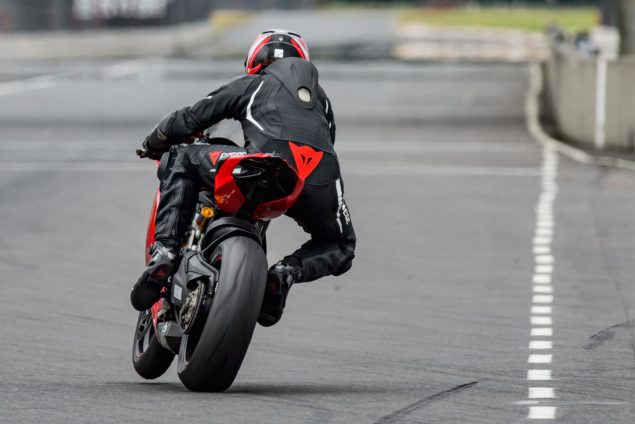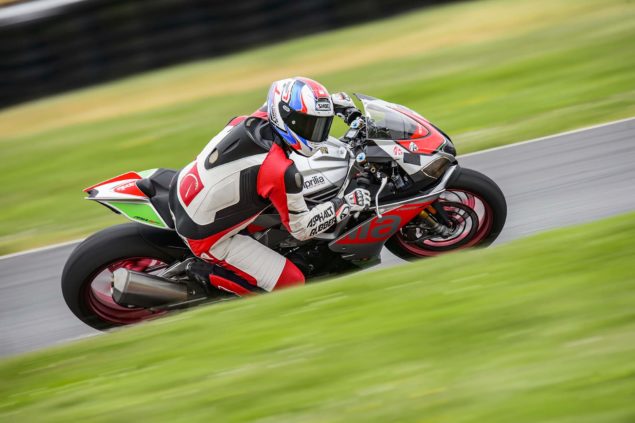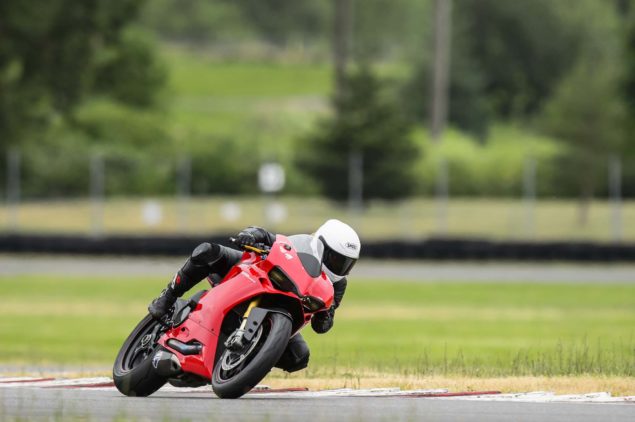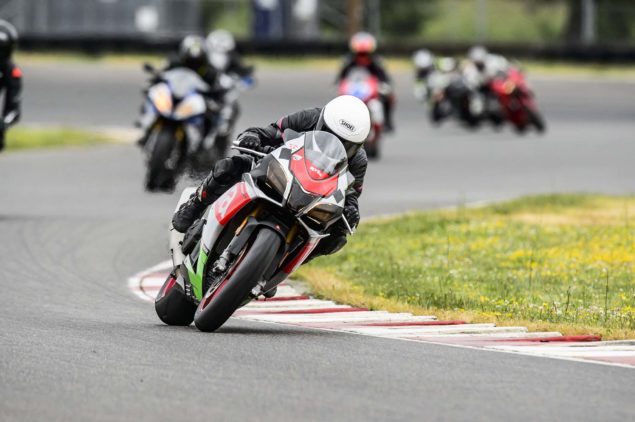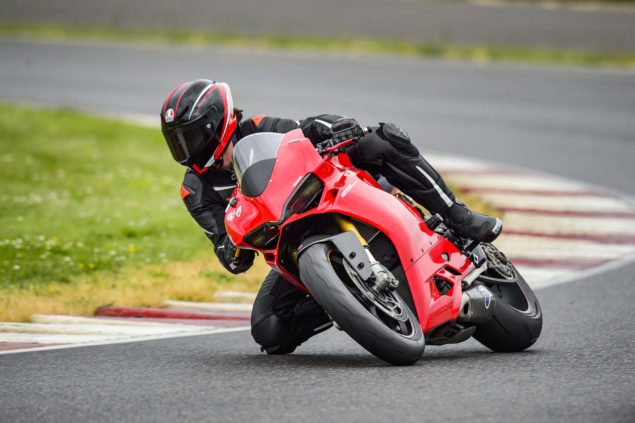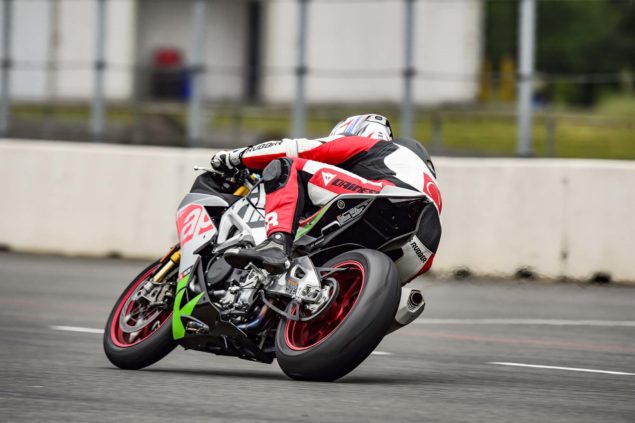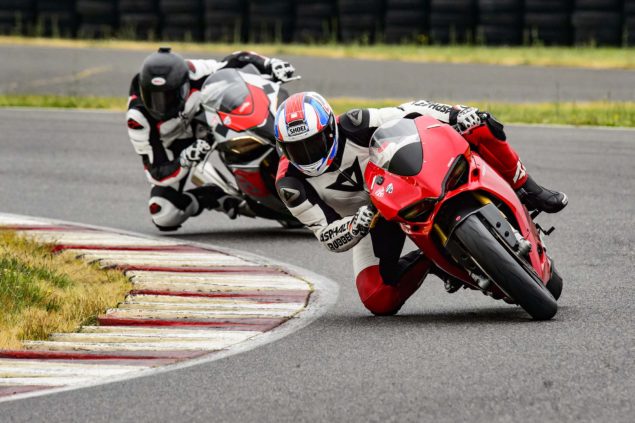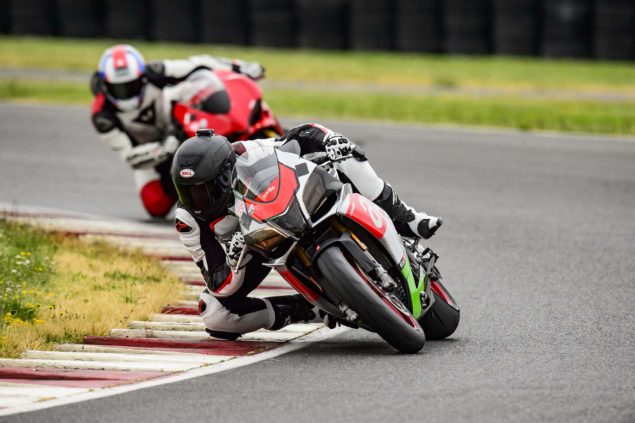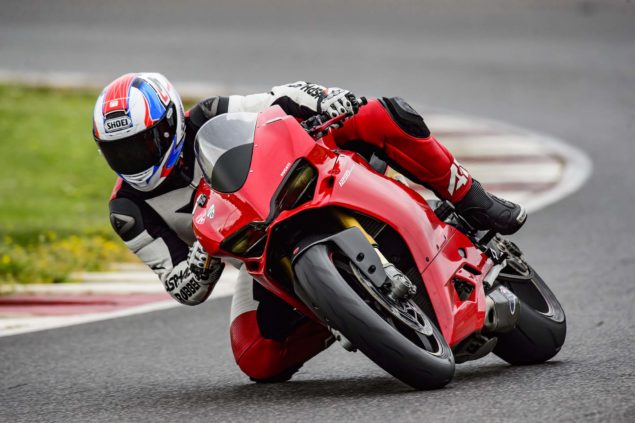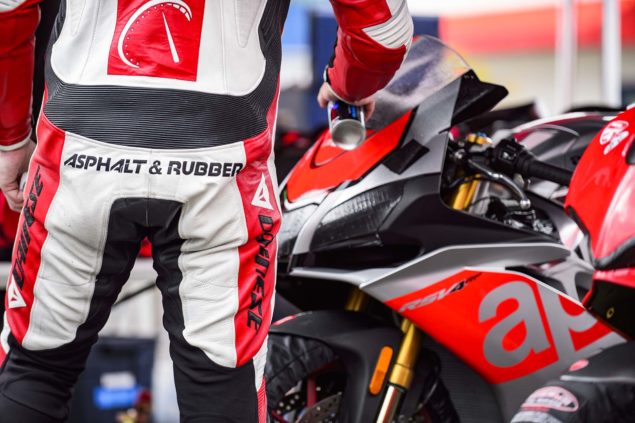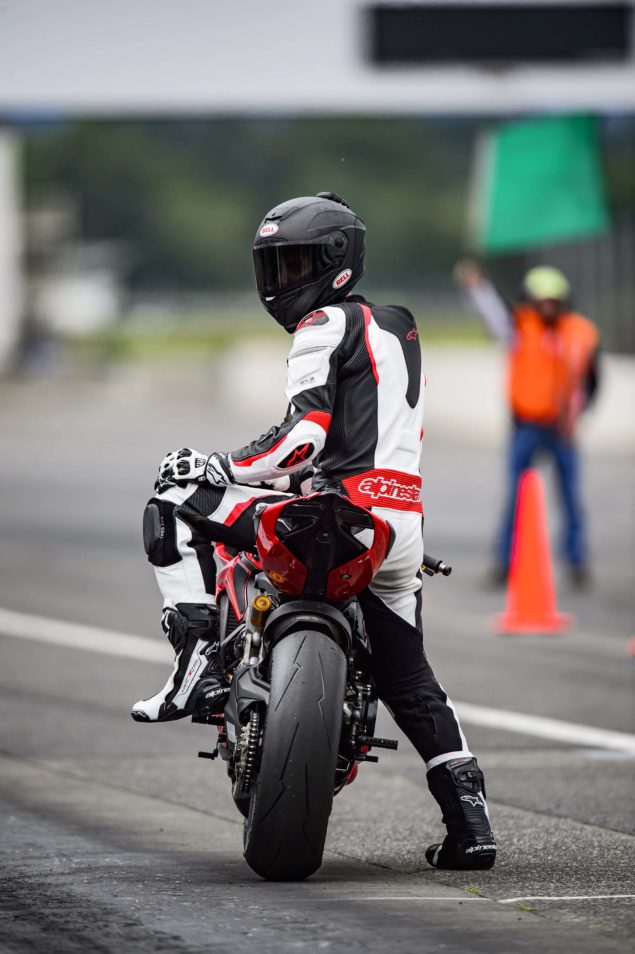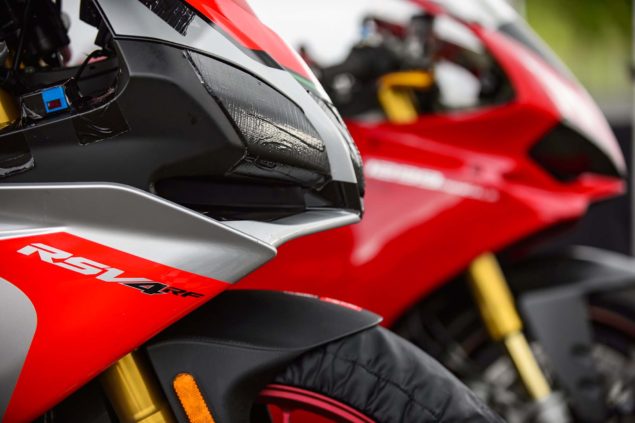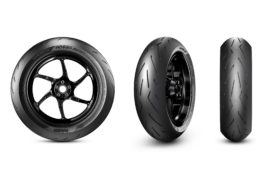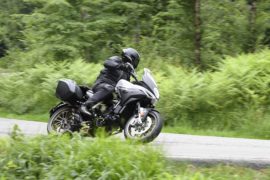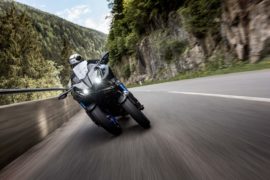Hello and welcome to the first installment of Asphalt & Rubber’s 2017 Superbike Deathmatch – our take on the motorcycle media’s superbike shootout review format, and the solitary path for a motorcycle to become the A&R Superbike of 2017.
For those just tuning into the Superbike Deathmatch, the rules are easy. In each round, two bikes enter the race track, but only one bike leaves.
We have six motorcycles from the eight superbike manufacturers on the market, and the trim-level for each bike has been carefully chosen so that all the superbikes have a similar price and feature set as the other motorcycles in the comparison.
This means that we are looking at motorcycles around the $20,000 price point, all of which have IMU-powered electronics and brakes, along with up-spec components. Our goal here is to compare apples to apples, and see which one tastes best.
Our venue is the Portland International Raceway, and to evaluate these machines we have four riders that vary in skill levels and physical attributes, from professional racers to track day enthusiasts, from tall to short, and from skinny to….less skinny.
For our first round, we have started things off with a special treat, and a battle for the right to call a bike the “Best Italian Superbike” on the market. That’s right, we are going to pit the Ducati 1299 Panigale S against the Aprilia RSV4 RF.
We should point out that you won’t find the Ducati 1299 Panigale models in other superbike shootouts, as Asphalt & Rubber is the only publication that included a Ducati in its 2017 superbike shootout format.
This is because Ducati North America went to great lengths to ensure that its flagship model was unavailable for any direct comparisons to other motorcycles – especially from any direct comparisons to that other Italian brand.
As you can imagine then, Ducati is not too pleased to see the Panigale’s inclusion in the A&R Superbike Deathmatch.
This is strange to us, because you would think that a company that built its reputation around its Superbike line of motorcycles would be keen to show-off its signature model, but alas, that was not the case. No bother, the A&R readership is strong, and provided us with a model to use anyways.
While we tried to find a bike that was completely stock, we should point out that the Ducati 1299 Panigale S we used for our evaluation did have a slip-on exhaust, rearsets, and crash-protection bits added. For our weight and dyno measurements though, we used a completely stock Ducati 1299 Panigale S.
We don’t think this swayed the results in any direction, but it is worth noting, for transparency.
First Impressions
Other than both models hailing from the country shaped like a boot, we couldn’t have picked two more unique motorcycles for our first Deathmatch round. The Ducati 1299 Panigale S is the only v-twin in our shootout, and the Aprilia RSV4 RF is the only V4.
On paper, the Ducati would seem to have the power-to-weight advantage with 205hp 194hp (Ducati has recently and quietly revised its horsepower ratings, supposedly to be more in line with European homologation requirements) and 420 lbs wet weight, to the Aprilia’s 198hp and 450 lbs wet weight figures.
The Ducati costs $2,800 more than the Aprilia, but both bikes feature Öhlins suspension (electric on the Ducati), forged aluminum wheels, and Brembo M50 brakes on 330mm discs.
Of course, the reality of how these two machines operate is very different from how the spec-sheet predicts. Going into the test, all four of our riders were unsure which bike would come out on top, and the final tally was a close one.
Previous iterations of the RSV4 were shown to be extremely competent on the race track, but the Panigale’s superior torque and lower weight would be an obvious asset on the very fast Portland International Raceway – a race track that highlights a superbike’s ability to generate power and get it down to the rear tire.
The Tale of the Tape
Of course, one can never take a manufacturer’s claimed figures on face value, so we put both superbikes on our own FIM-certified two-wheel scale, and SAE-corrected DynoJet dynamometer to see what the true “Tale of the Tape” looked like.
As you can expect, there was some divergence from the official spec sheets from both Aprilia and Ducati.
To see what the real-world rear-wheel horsepower looked like, we took both bikes down to Cycletune, a well-respected local service shop here in Portland, Oregon. The results confirmed a narrow gap between the revised quoted horsepower and torque figures.
| Aprilia RSV4 RF | Ducati 1299 Panigale S | |
| HP* | 177.25 HP @ 13,090 rpm | 178.76 HP @ 10,220 rpm |
| Torque* | 77.22 lbs•ft @ 10,830 rpm | 97.04 lbs•ft @8,560 rpm |
| Wet Weight* | 465 lbs | 431.5 lbs |
| Front/Rear Bias* | 50.6 / 49.4 | 52.5 / 47.5 |
| Adjustable IMU-Powered Electronic Packages | ||
| Wheelie Control | X | X |
| Launch Control | X | |
| Engine Braking Control | X | |
| Rear Wheel Lift Control | X | X |
| Electronic Suspension | X | |
| MSRP | $22,999 | $25,795 |
*Figures measured by Asphalt & Rubber’s two-wheel scale and dynamometer
The obvious takeaway is that the power to the rear wheel is considerably less than the at the crank figures the manufacturers use.
But, even with Ducati correcting its claimed peak power figure to 194hp, 4hp less than the Aprilia, the Panigale S makes just a tad more power on the dyno, with obviously a larger amount of peak torque, which comes on notably lower in the rev range.
The Ducati 1299 Panigale S makes the most horsepower out of all the bikes we measured for the 2017 Superbike Deathmatch, with the Aprilia RSV4 RF being the second most powerful machine, making this a close match-up in terms of power.
On our sophisticated two-wheel scales, both models recorded heavier weights than both manufacturers claim, though they are on opposite ends of the spectrum in terms of the wet weight spectrum (say that three times fast).
The Ducati 1299 Panigale S is a far cry from the claimed 420 lbs, but at 431.5 lbs fully fueled, it is still the lightest superbike on the market.
Aprilia’s claimed 450lbs wet weight is oddly done without fuel, for the 2017 model year, perhaps because the RSV4 RF has the largest fuel tank out of the superbike models (4.9 gallons). Unsurprisingly then, the Aprilia RSV4 RF weighs 465 lbs when fully fueled – the heaviest from the 2017 superbike class.
Both bikes feature a robust electronics suite, and offer considerably more adjustability than any other bike in our Superbike Deathmatch. This made for a busy day on the race track, as we tried different settings and configurations to extract the most potential from each machine.
On the Gas
Getting the power to the pavement showed a different story from the dyno though, with our tamed road racer Andy DiBrino posting fairly different trap speeds down Portland International Raceway’s ¾-mile long front straightaway: Ducati 174 mph; Aprilia: 178 mph.
As the name implies, the Ducati 1299 Panigale S packs more engine displacement than the Aprilia, to the tune of 286cc – a 28% displacement advantage over the Aprilia.
On the race track, the Ducati’s horsepower is very potent, but also very raw. The Panigale S pulls hard when lower in the rev range, showing off its class-leading torque figures, but peters out in power as its Superquadro engine climbs past 8,500 rpm.
This contrasts with the Aprilia, which showed superior power as it revved through the top-end of the powerband. The power was also very linear, something our dyno charts confirmed. The RSV4 RF not only makes a lot of power, it makes it very easy to use – a notable advantage.
“The power on the Panigale S felt like it had more bottom-end, whereas the RSV4 RF felt more mid to top-end,” said racer Andy DiBrino. Our track day enthusiast test rider Hannah Johnson echoed that sentiment as well.
“The Ducati was definitely a kick in the pants torque monster. Definitely something to hang onto,” she told us. “Where the powerbands were on both bikes though, I have to give the Aprilia credit on that one. The RSV4 RF had more power on the top-end, but it didn’t suffer much on the torque down low.”
On the track, this contrast continues, with the Panigale S being easier to accelerate out of the slower corners, while the RSV4 RF lends itself to being better suited for the faster flowing sections at PIR.
Both the Ducati 1299 Panigale S and the Aprilia RSV4 RF have independently adjustable wheelie control settings (about half the superbikes on the market allow independent wheelie control adjustment), which is powered by the bikes’ inertial measurement units (IMUs).
While the Aprilia APRC electronics suite is highly regarded in the motorcycle industry, our tests showed it not to be perfect system, with the anti-wheelie control (AWC) causing some acceleration issues out of the bus-stop Turn 4 at PIR.
This lead to several of our riders turning the AWC setting to “OFF” for a better lap time, rather than using one of the three rider-selectable levels of intervention. Making matters worse was the inconsistency of when the AWC would rob power from the rear wheel, when it seemingly didn’t need to do so.
The eight-level Ducati Wheelie Control (DWC) system on the other hand was incredibly seamless, which helped the Panigale S to be the better motorcycle out of the tighter turns.
Having more levels of adjustment helped the Panigale S in this regard as well, though we are not quite sure that riders will notice huge differences between all eight toggle levels.
“The Aprilia, for sure it has the advantage on the straight away, but I preferred the Ducati on the slower corners, because I felt I could get on the power quicker. I for sure was getting out of Turn 4 quicker on the Ducati than I was on the Aprilia,” explained DiBrino.
“I also felt the wheelie control was less intrusive on the Ducati, whereas the Aprilia, coming out of Turn 4, I really didn’t feel like I was accelerating out until halfway through the corner and going into Turn 5. The wheelie control felt really restrictive.”
Turning our attention to the throttle connection for the two bikes, we again found some disparity between the Aprilia and the Ducati.
In this case, it was the Aprilia with the superior electronic option, as the RSV4’s superior ride-by-wire was far easier to use for small throttle adjustments, while the Ducati’s was a bit harsher in its smaller throttle inputs.
The ride-by-wire on the Ducati is still quite good, but the Aprilia’s has just that extra bit of positive feel from the handlebar, and a more connected feeling, so what is being inputed by the rider is being translated to the throttle bodies.
This made the Aprilia very controllable and easy to manage, whereas the Ducati was comparatively a bit less tame when it came to small corner corrections via throttle input.
At our chosen price point, all the models come fitted with up-and-down quickshifters, a sign that this technology is becoming more popular in the sport bike category.
Ducati was one of the first brands to fit an up-and-down quickshifter to its superbikes, and the system is very competent. But here, Aprilia shows how refined its electronics package is on the race track.
“The quickshifter wasn’t as smooth on the Ducati. I felt it jolting my head forward on the straightaway,” complained DiBrino, about the Panigale S.
The Aprilia RSV4 RF sets the high-water mark for how quickshifter should work, getting praise from all four of our riders.
The Ducati system is still quite good, compared to some other bikes on the market, but it misses that little extra bit of smoothness that comes with the Aprilia. As such, there can be a jolting motion on up-shifts with the Ducati, which doesn’t happen on the Aprilia.
In the end, the linear power of the Aprilia was massively impressive, and is part of what makes the RSV4 RF such a great machine. The bike’s V4 engine could easily be the work of Claude Monet.
And if that’s the case for the Aprilia, then the Ducati 1299 Panigale S can be regarded as something created by Jackson Pollock. Impressive, beautiful in its own way, but also chaotic. All of our test riders commented about how “raw” the v-twin engine was in the way it delivered power, which is both a compliment and a complaint.
There is something very visceral to the Ducati, while the Aprilia seems more refined and well-mannered, in terms of how these bikes make their power and delivery it to the tarmac.
“The Aprilia is like a turbine. I do enjoy that,” said my Two Enthusiasts Podcast co-host, Quentin Wilson.
“The RSV4 was a lot easier to ride, and I didn’t have to spend as much brain power to think about my inputs. I could just ride the bike and ride it fast, without having to control this unwieldy monster,” added Hannah Johnson.
On the Brakes
Going fast is only part of the equation though, and as the comic books say, “with great power, comes great responsibility”. In the superbike world, that means that with near-200hp power figures dominating the headlines, there is also the requirement for equally great stopping forces on these machines.
With both the Aprilia and the Ducati having very similar suspension and braking packages on their respective “RF” and “S” trim-level bikes, our tests made it clear that these superbikes are greater than the sum of their parts.
During our track time, these two bikes showed their true personalities, both during the harsh braking zones at PIR (Turn 1, Turn 4, & Turn 7) as well as the softer transition points on the track (Turn 2, Turn 3 & Turn 9).
Both the RSV4 F and the Panigale S come with Brembo M50 calipers, Brembo 330mm steel rotors, and Brembo radial master cylinders – with IMU-powered cornering ABS fitted by Bosch to both bikes as well.
In terms of the braking package, the subtle differences in Ducati’s setup provided better stopping potential from the front wheel, with the Panigale’s brakes showing strong bite and good modularity as you approach the turn-in point.
The RSV4s’s brakes are no slouch either, but lacked the lever-feel that came with Panigale’s setup, especially when going into Turn 7. Getting hard on the binders there, it was easy to feel the rear-wheel lift on the ABS taking control, as the rear-end of the bike lifted off the ground.
“On the brakes, I thought the Aprilia was fine, but I hadn’t ridden the Ducati yet,” said Quentin Wilson. “I could threshold brake on the RSV4 RF, but I didn’t have the confidence to trail brake.”
“I was trail-braking a little, but nowhere near what I do when I’m racing, and when I’m racing that’s where most of my lap time comes,” he added.
“As soon as I got on the Ducati, the amount of threshold braking I could get, and the feel to be able to trail brake really far into Turn 1 — still not as far as I can when I’m racing — but I felt like I could have kept pushing. That was really good. It was remarkable,” he continued.
Modulating the rear-wheel lift on the Aprilia RSV4 RF became a part of the braking task here, and was complicated by the vague lever-feel, whereas the Ducati was much better at keeping its wheels on the ground, providing more feedback to the rider through the brake lever.
Don’t let this sway you on the Aprilia RSV4 F though, as it and the Ducati were some of the most competent bikes on the brakes in our review process, and both machines showed tremendous braking force, likely thanks to the Brembo units and the larger 330mm discs.
While the Ducati was better at slowing down, the Aprilia was far more stable on the brakes, which lent itself to being better suited for turn-in to the apex.
“As far as the chassis goes, they both feel long. When you look at the Aprilia, it looks tiny, but I know that it’s not,” said Quentin. “I’m trying to get my head around where the center of gravity is.”
“But the Ducati’s center of gravity is way lower. It feels super good on the brakes, because you feel like that center of gravity was working for you.”
“I didn’t ever feel like the Ducati was going to bring up the rear-end, whereas all the time on the Aprilia it felt like it was going to lift the rear. Going into Turn 7 a couple of times, I got it to wag a little bit. If the same thing happened on the Ducati, it would just hunker down.”
Hannah had a different perspective about the two machines, however. “The Aprilia definitely gave me a lot more confidence going into the braking. It felt like a little bike. You could change your line instantaneously. It was easy to flick in and out.”
“The Ducati is very solid and very stable. But, it takes a little bit more muscle in order to change more line on the Panigale,” she added.
In the Turns
Similarities between the RSV4 RF and Panigale S continue when you get to the chassis pieces, as both machines use suspension provided by Swedish powerhouse Öhlins suspension.
The Ducati 1299 Panigale S adds some tech in this department though, with its Öhlins forks and rear shock being electronically controlled, with semi-active suspension pieces that can be manually overridden.
For a short-term evaluation like ours, this gave the Ducati 1299 Panigale S the advantage, as the electronic suspension made changing setups as easy as hitting a button.
We also found the Ducati’s dynamic settings on its suspension to provide a good baseline setup for track use, whereas on the Aprilia we were left turning wrenches after each session.
Again, both machines proved to be more than the sum of their parts, with the Ducati and Aprilia superbikes showing strengths and weaknesses in different areas of the track.
“The chassis felt pretty similar,” said Andy DiBrino. “Overall, they both felt balanced, and I was able to push really hard on them.”
The front-end of the Ducati felt planted, and gave good feedback from the braking point, all the way to the apex. But while the Aprilia was slower to lean over onto its side, the RSV4 RF chassis package was much more stable leaned over, and made for easy line correction.
“The Aprilia definitely gave me a lot more confidence. You could change your line instantaneously, and it was easy to flick in and out.” said Hannah. “The Ducati is very solid and very stable. But, it takes a little bit more muscle in order to change the line while on the Panigale S.”
Our tamed racer agreed, and noted how the Aprilia’s throttle response also helped make the RSV4 RF better in the turns.
“I liked the Aprilia better through the flowing sections, because the throttle response was quicker, whereas the Ducati not so much,” said Andy.
“The Ducati felt really stable on the back straightaway though, surprisingly. I know a few people on the older models had issues with the single-sided swingarm – it would wallow a bit. But, the Ducati 1299 Panigale S was locked in.”
Quentin Wilson agreed with the other riders about how planted the Ducati felt, saying that “the Ducati got better as it got faster” and that “the Ducati came more into tune, the harder you pushed it.”
But he also acknowledged the big weakness on the Panigale S during our test. “The Ducati had a hesitation, between maintenance throttle and on-throttle when you’re mid-corner, that I didn’t like,” said Wilson.
“It would happen a lot in Turn 4, which is a critical place to pick-up the throttle and go. So, that was disconcerting.”
While the Aprilia RSV4 RF required more force to turn and lean over, it was adept at line changes. This is almost opposite to the Ducati, which was easier to move on the track, physically, but was prone to under-steer and harder to correct.
The Judges’ Rulings
Putting all these thoughts together, our vote for a winner was unanimous, though our scorecards showed a very narrow victory for the 2017 Aprilia RSV4 RF.
In the end, the RSV4 RF had a superior ability to get the power down through the tires and onto the tarmac. Aprilia has also done an incredibly good job making a bike that is easy to ride, and easy to ride fast.
The Ducati 1299 Panigale S showed itself to be a fantastic machine as well, and perhaps at a track with more tight turns, the lap times would have favored Borgo Panigale’s namesake.
At over a second slower in the hand of racer Andy DiBrino, the objective testing of the Panigale showed it lacking the total package that comes with the RSV4 RF.
Subjectively too, all of our riders gushed about the Aprilia’s attributes, whereas the Ducati seemed more to be a novelty with curious high-points.
Andy DiBrino – MotoAmerica Racer & OMRRA #1 Plate Holder:
“The Ducati felt very stable. It just felt rock solid around the track. I didn’t have any issues with the bike getting upset.”
“The suspension package was really good. There was no dive on hard braking, so I felt like I had good stability going into the corners. I thought the tire wear was really good, and the feel with the back-end.”
“On the Aprilia, the shifting was a high-point, the power was a high-point, and the throttle responsiveness was a high-point.”
“I picked the RSV4, since the negatives are easy fixes, and I was already over a second faster per lap on the Aprilia. I felt more comfortable on the Aprilia, and I liked the power. The RSV4 RF feels more like a race bike. ”
“The reason I didn’t pick the Ducati, it was just way too slow with the stock gearing.”
“Overall, the bike just felt really average. There just wasn’t anything about the Ducati that made me say ‘wow, this is really good’. The Aprilia maybe didn’t have the highest marks everywhere, but it felt like it had the most potential of the two bikes.”
“The only small gain I saw the Ducati have over the Aprilia was maybe the electronics, because the wheelie control was less intrusive.”
Quentin Wilson – Former Pro/Am Racer & Two Enthusiast Podcast Host:
“First impression of the Aprilia was that it was of immediate comfort, super simple to ride, super comfort level, even when it was chilly in the morning. Right off the bat, that bike was like ‘click, click, click’ everything fell into place. No problem, it was really easy to ride.”
“The Ducati is just more of a handful. To go out and ease-in on that bike is just not as simple. It has a lot of quirks, and those quirks manifest themselves more when you ride slow.”
“I was surprised at how good the Ducati was though. I was like, ‘wow’ – that Aprilia was really good off the bat, but holy shi!t does that Ducati still feel really good on the brakes!”
“That rawness is like the difference between a scalpel and a machete, with the Ducati being the machete.”
“They both cut, but on that Ducati, you have to wield it in a very specific way to make the same cut as a scalpel. The Ducati was harder to ride, and I think for me a little suspension tuning would make the Aprilia pretty damn good. However, the fact that the Ducati does that as-shipped is of note.”
Hannah Johnson – OMRRA Racer & Track Day Enthusiast:
“The Ducati is this amazingly brutal machine, but the Aprilia is so much smoother and so much easier.”
“The Ducati was a blast to ride, but I wouldn’t be able to ride it all day and maintain the same type of speed. Whereas on the Aprilia I could ride all day, and still be consistent.”
“If I had to buy a bike today, I would buy that Aprilia. I don’t have to spend as much brain power on my inputs – I can just ride it. It doesn’t wear me out.”
“I’m not very tall and I’m not very big, so having to muscle around a bike is a huge factor for me, and the Aprilia was just easy. It felt like a little bike, but it was really fast.”
Jensen Beeler – Asphalt & Rubber’s Chief Kneedragger:
“At the end of the day, I am not surprised that the Aprilia was the better bike around the track, but what did surprise me was how close these two machines are in my rankings.”
“You couldn’t pick two more different motorcycles to compare, and for them to be so close on the scorecard is really impressive.”
“For me, the Aprilia had to be the winner though. It brings so much to the table, especially that V4 motor. My only major complaint with the RSV4 RF is how slow it makes its rolling side-to-side transitions – you can really feel the weight of the machine in the s-curves.”
“The Ducati is rewarding and fun in its own right, and it was easy for me immediately to go fast on the Panigale S. But, the Ducati is missing that extra something that makes a good track bike a great track weapon…and this is a Superbike Deathmatch, after all.”
“I wouldn’t kick either bike out of my garage, if I woke up one morning and found them there. But if both bikes were at the track and ready to go, I know which one I’d be spending more laps on, and it’s the 2017 Aprilia RSV4 RF.”
Winner: 2017 Aprilia RSV4 RF by a 4-0 Vote
The Asphalt & Rubber Superbike Deathmatch is made possible by our riders: Andy DiBrino, Quentin Wilson, Hannah Johnson, and Jensen Beeler.
A big thank you goes out to our local PNW motor-supporters as well: Dyno & Service: CycleTune & Aprilia Moto Guzzi Portland; Track Days: MotoCorsa, 2 Fast, & Track Time; Gear: AGV & Dainese.
Photos: © 2017 Ryan Phillips / 360° Photography – All Rights Reserved


